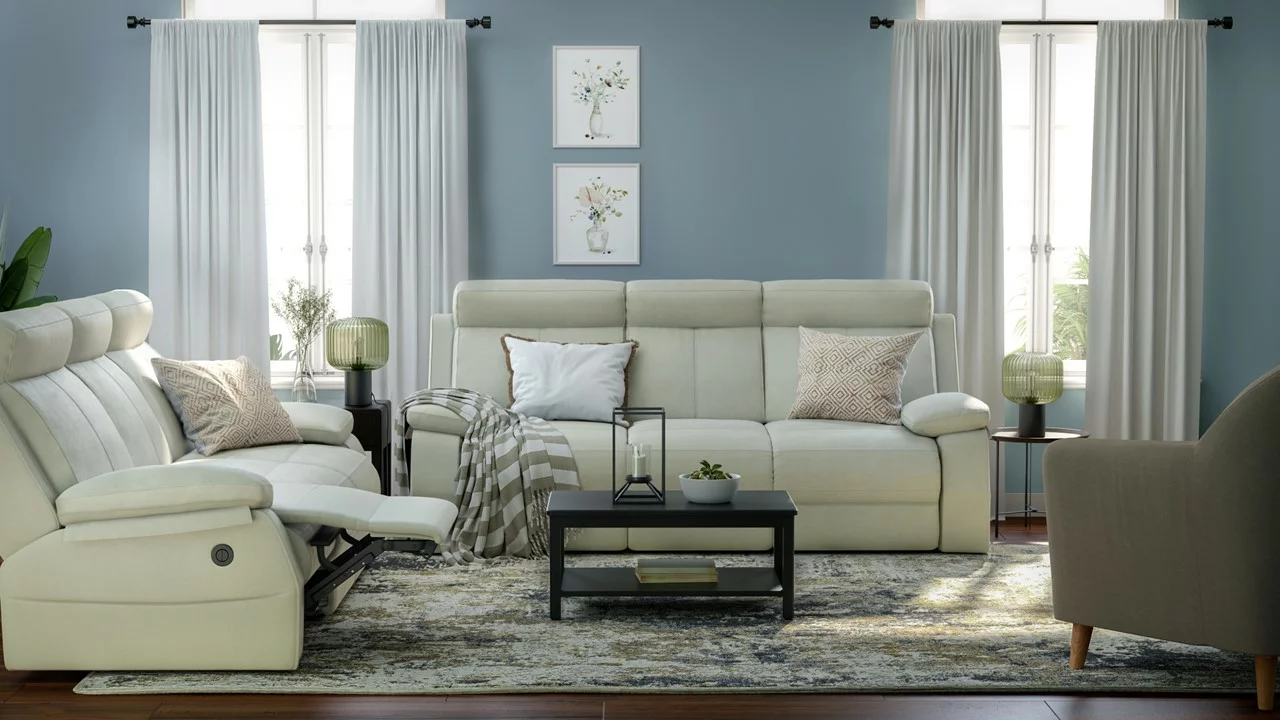
In our daily hustle, the living room becomes more than just a space; it’s our retreat, our entertainment hub, and where we unwind after a long day. Yet, how often have we settled into our couches only to find discomfort in what should be our cosiest corner? Pursuing the perfect living room setup is a common quest among many, driving the demand for furniture that isn’t just visually appealing but ergonomically supportive. In this blog, we explore how these pieces are designed with our body’s natural posture in mind and tailored to enhance our living spaces’ aesthetics and functionality.
-
Sofa Selection:
Choosing ergonomic furniture for your living room, particularly sofas, requires a keen emphasis on ensuring both comfort and support to avoid any potential discomfort, pain, or long-term health complications. Ergonomics in furniture design ensures that the furniture fits the user’s body and supports areas that need it most, such as the back, neck, and legs. For sofas, key elements include a high back, firm but comfortable cushions, and adjustable armrests to accommodate various body types and preferences. The sofa should also be wide enough to seat your family comfortably.
This includes lumbar support to maintain the spine’s natural curve, adjustable features to customise the fit, and cushioning that promotes proper posture and movement. Investing in such a sofa provides immediate comfort and contributes to your long-term well-being by preventing musculoskeletal disorders. In addition to sofas, consider incorporating ergonomic chairs and recliners, which offer adjustable features like armrests, headrests, and lumbar support. These features are essential for maintaining proper posture and reducing the risk of aches and pains associated with prolonged sitting. Recliners, for example, often feature plush cushioning and soft upholstery, providing a luxurious seating experience while supporting your body in various positions.
-
Ergonomic Chairs and Recliners:
Selecting the right ergonomic chairs and recliners is crucial for those looking to maximise comfort in their living spaces. Ergonomic living room furniture supports your body’s natural posture, reduces strain on your back and neck, and enhances overall comfort during relaxation or entertainment activities.
Key Considerations for Ergonomic Chairs and Recliners:
- Many ergonomic chairs offer adjustable footrests, backrests, and armrests to tailor the seating experience to your body’s needs. For instance, some chairs provide a reclining angle of up to 150° and adjustable footrests for ultimate relaxation.
- Look for chairs with highly padded armrests, backrests, footrests, and cushions. Certain models also feature heating massage options to help reduce back pain and provide relief.
- High-quality materials such as PU leather, durable steel frames, and skin-friendly fabrics are common in ergonomic chairs, ensuring comfort and longevity.
- Whether you prefer a minimalistic design or a chair that makes a statement, ergonomic options are available in various colours and styles to complement your living room decor.
- Some recliners have massage functions, heating options, cup holders, and storage bags, adding convenience and enhancing your relaxation experience.
-
Sectionals:
Ergonomic sectionals are an excellent choice for enhancing comfort and functionality in your living room. Designed with ergonomics in mind, these sectionals offer ample support and adaptability to fit the natural contours of your body, ensuring optimal comfort and reducing the risk of discomfort or long-term health issues related to poor posture.
Key Features to Look for in Ergonomic Sectionals:
- Seek out sectionals with adjustable armrests and headrests to personalise your seating experience. This customisation allows for proper support of your neck, back, and arms, catering to individuals of various heights and seating preferences.
- Opt for sectionals that provide firm yet comfortable cushioning. High-density or memory foam options can offer support and comfort, ensuring the seating does not contribute to slouching or spinal misalignment.
- Consider sectionals covered in durable and easy-to-clean materials like linen, cotton, or synthetic microfiber. These materials can withstand daily use while maintaining their appearance and comfort level over time.
- Some ergonomic sectionals have built-in storage options, such as compartments or drawers. This feature can help maximise space in your living room by offering a place to store blankets, remotes, and other essentials.
- Ergonomic sectionals are available in various sizes and configurations, making them suitable for rooms of any size. An ergonomic sectional fits your space and seating needs, from smaller L-shaped designs to larger U-shaped models.
-
Chair Adjustability:
Adjustable armrests, seat heights, and lumbar support are crucial for tailoring a chair to your personal comfort needs. Such features enable individuals of different heights and body types to find their optimal sitting position, which is particularly important in shared living spaces. Adjustable chairs cater to dynamic sitting, allowing changes in position throughout the day to promote blood circulation and reduce muscle strain.
The chair should complement the spine’s natural curves, supporting areas prone to pressure points, such as the lower back and hips. The relationship between a chair’s design and body mechanics significantly enhances comfort and prevents long-term health issues.
-
Versatile Seating Options:
Flexible seating options are crucial for living rooms that serve multiple purposes, including reading, TV viewing, socializing, or remote work. Seating that’s adaptable, movable, or transformable ensures the space remains versatile and can be tailored to suit the varying requirements of each day. Furniture that can be easily moved, adjusted, or converted allows for a dynamic living space that can change according to the day’s needs. For instance, modular sofas, recliners with adjustable features, and chairs offering additional storage can perfectly balance functionality and style.
Examples of Ergonomic Seating Solutions
- Modular Sofas: These can be reconfigured to suit different occasions, whether you need a large sectional for movie nights or separate seating areas for hosting guests. Modular sofas often come with removable sections that can serve as standalone chairs or ottomans.
- Recliners with Built-in Support: Recliners that offer adjustable lumbar support, headrests, and footrests can cater to individual comfort preferences, making them ideal for relaxation and reducing strain on the body.
- Convertible Sofa Beds: Sofa beds offer a versatile solution by acting as a comfortable sofa by day and transforming into a bed for overnight guests, thus enhancing the functionality of your living area without compromising on comfort or aesthetics.
- Accent Chairs with Adjustable Features: Chairs that include adjustable height, seat depth, and tilt can offer personalised comfort and support, making them a versatile addition to any living room. These chairs are perfect for creating a cosy reading nook or extra seating for social gatherings.
Choosing the right furniture isn’t just about filling spaces; it’s about creating nooks for comfort, laughter, and relaxation that resonate with us and our loved ones. Choosing ergonomic furniture isn’t just about bringing a sleek or modern aesthetic into our homes; it’s about crafting environments that support our well-being, encourage relaxation, and adapt to our ever-changing rhythms.







